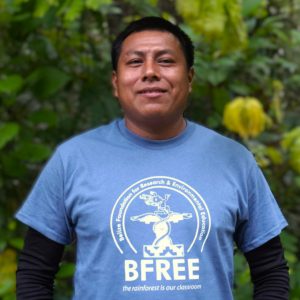Blog
Land Snail Workshop at BFREE
The first workshop on the Land Snails of Belize was led by biologists, Dan and Judy Dourson, and took place at the BFREE field station in late February. The workshop’s goal was to give participants an understanding of which snails can be found in southern Belize and to train them to identify land snails with…
Read MoreNew Rearing Pond at the Hicatee Conservation & Research Center
Designed to study the reproductive biology and to determine if the Central American River turtle could be bred in captivity, the Hicatee Conservation & Research Center opened in 2014 and was met with immediate success when, in the summer of 2015, the first seven hatchlings emerged. This was followed by five hatchlings in 2016, 84…
Read MoreBirds, Chocolate, Forests, and Allegheny College
Allegheny College students pose for a photo at BFREE during the Birds, Chocolate, Forest Field Course in May 2019. Written By, Beth Choate, Ph.D.Associate Professor, Environmental Science and SustainabilityAllegheny College BFREE’s Birds, Chocolate and Forests course provided students with a real life example of the complexities of conservation within the rainforests of southern Belize. Through…
Read MoreHerp Survey at BFREE
Article by, Iris Holmes This May, a group of researchers from the University of Michigan and the University of California, Berkeley, visited BFREE to do a survey of amphibians and reptiles. They worked for two weeks, both on the BFREE property and at Mountain Pine Ridge Forest Reserve. Between these places, they recorded 47 species.…
Read MoreBFREE Receives Porras Conservation Award
It’s not often international wildlife conferences hold their annual meeting so close to home. Fortunately, the International Herpetological Symposium (IHS) chose Belize City as the base for their 42nd gathering and we are so glad they did! The International Herpetological Symposium (IHS) provides a forum for the dissemination of information and research pertaining…
Read MoreNew Rearing Pond at the Hicatee Conservation & Research Center
Designed to study the reproductive biology and to determine if the Central American River turtle could be bred in captivity, the Hicatee Conservation & Research Center opened in 2014 and was met with immediate success when, in the summer of 2015, the first seven hatchlings emerged. This was followed by five hatchlings in 2016, 84…
Read MoreTeam Hicatee Competes in La Ruta Maya
By Jaren Serano The La Ruta Maya 2019 Belize River Challenge is considered one of the most gruesome races in Belizean history and it is the longest canoe race in Central America: a four- day event covering over 180 miles of Belizean river. Paddlers from all corners of the country and internationally converge at the…
Read More17 New Species of Land Snails Discovered in Belize
17 New Species of Land Snails Discovered in Belize By Dan and Judy Dourson The beautiful country of Belize, known to the rest of the world for its stunning reef and adventure tourism, has a new claim to fame as home to seventeen new species of land snails! This information was uncovered thanks to a long-term study…
Read MoreInternational Herpetological Symposium 2019 in Belize
Next June, the International Herpetological Symposium (IHS) will held at the Best Western Plus Belize Biltmore Plaza in Belize City. The mission of the IHS is to provide a forum for the dissemination of information and results of such research pertaining to the natural history, conservation biology, and captive management and propagation of amphibians and reptiles. Each year…
Read MoreSoaring with Solar
After 23 years of BFREE being an off-the-grid solar powered field station, nothing has changed, except now we have a centralized 7.5 kw state of the art solar system which is 7 -10 times more productive and has energy storage capacity more than 20 times what was on-site before. The system also has a backup…
Read More



